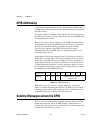
Chapter 8 NI-488.2 Programming Techniques
© National Instruments Corporation 8-17 NI-488.2 User Manual
Example 2: Using AllSpoll
This example shows you how to use AllSpoll to serial poll three devices
with a single call:
void GetAllSerialPollResponses ( Addr4882_t AddrList[],
short ResponseList[] )
{
int WaitResult;
WaitSRQ (0, &WaitResult);
if ( WaitResult ) {
printf ( "SRQ is asserted.\n" );
AllSpoll ( 0, AddrList, ResponseList );
if (!(ibsta & ERR)) {
for (i = 0; AddrList[i] != NOADDR; i++) {
printf ("Device at pad %x returned byte
%x.\n", AddrList[i], ResponseList[i] );
}
}
}
return;
}
Parallel Polling
Although parallel polling is not widely used, it is a useful method
for obtaining the status of more than one device at the same time.
The advantage of parallel polling is that a single parallel poll can easily
check up to eight individual devices at once. In comparison, eight separate
serial polls would be required to check eight devices for their serial poll
response bytes. The value of the individual status bit (
ist) determines the
parallel poll response.
Implementing a Parallel Poll
You can implement parallel polling with either the traditional or
multi-device NI-488.2 calls. If you use multi-device NI-488.2 calls to
execute parallel polls, you do not need extensive knowledge of the parallel
polling messages. However, you should use the traditional NI-488.2 calls
for parallel polling when the GPIB interface is not the Controller, and the
interface must configure itself for a parallel poll and set its own individual
status bit (
ist).


















